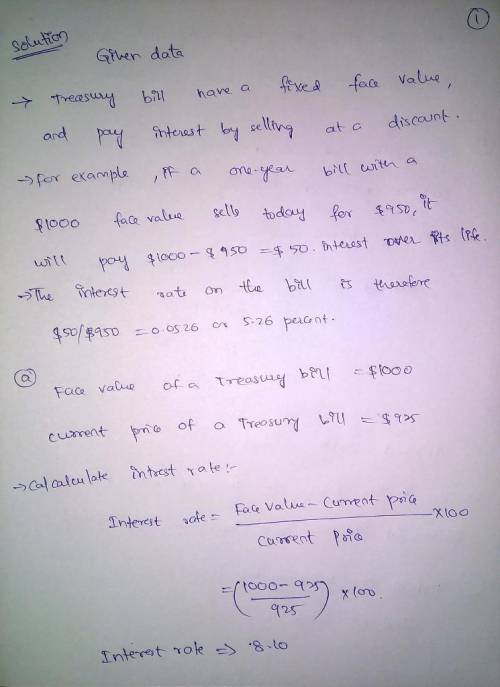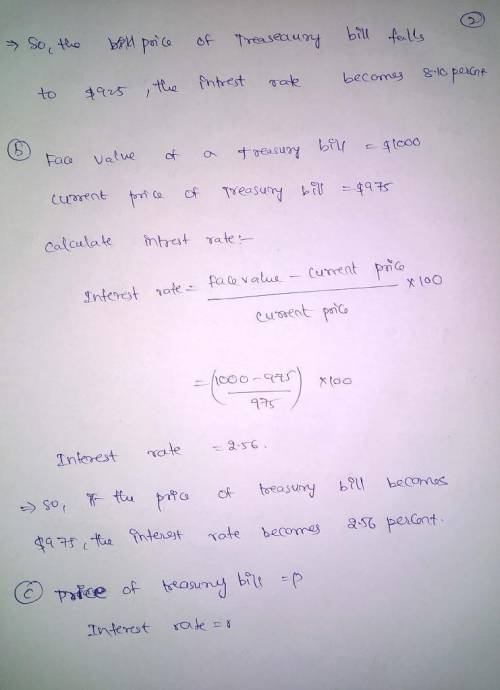
Treasury bills have a fixed face value (say, $1,000) and pay interest by selling at a discount. for example, if a one-year bill with a $1,000 face value sells today for $950, it will pay $1,000 $950 $50 in inter- est over its life. the interest rate on the bill is there- fore $50 $950 0.0526, or 5.26 percent. a. suppose the price of the treasury bill falls to $925. what happens to the interest rate? b. s uppose, instead, that the price rises to $975. what is the interest rate now? c. (more difficult) now generalize this example. let p be the price of the bill and r be the interest rate. develop an algebraic formula expressing r in terms of p. ( hint: the interest earned is $1,000 − p . what is the percentage interest rate? ) show that this formula illustrates the point made in the text: higher bond prices mean lower interest rates.

Answers: 1
Other questions on the subject: Business

Business, 21.06.2019 17:10, IsabelAyshi
Show the changes to the t-accounts for the federal reserve and for commercial banks when the federal reserve buys $50 million in u. s. treasury bills. if the public holds a fixed amount of currency (so that all loans create an equal amount of deposits in the banking system), the minimum reserve ratio is 10%, and banks hold no excess reserves, by how much will deposits in the commercial banks change? by how much will the money supply change? show the final changes to the t-account for commercial banks when the money supply changes by this amount.
Answers: 3

Business, 22.06.2019 01:30, ykluhredd
Side bar toggle icon performance in last 10 qs hard easy performance in last 10 questions - there are '3' correct answers, '3' wrong answers, '0' skipped answers, '1' partially correct answers about this question question difficulty difficulty 60% 42.2% students got it correct study this topic • demonstrate an understanding of sampling distributions question number q 3.8: choose the correct estimate for the standard error using the 95% rule.
Answers: 2

Business, 22.06.2019 03:00, sayedaly2096
5. profit maximization and shutting down in the short run suppose that the market for polos is a competitive market. the following graph shows the daily cost curves of a firm operating in this market. 0 2 4 6 8 10 12 14 16 18 20 50 45 40 35 30 25 20 15 10 5 0 price (dollars per polo) quantity (thousands of polos) mc atc avc for each price in the following table, calculate the firm's optimal quantity of units to produce, and determine the profit or loss if it produces at that quantity, using the data from the previous graph to identify its total variable cost. assume that if the firm is indifferent between producing and shutting down, it will produce. (hint: you can select the purple points [diamond symbols] on the previous graph to see precise information on average variable cost.) price quantity total revenue fixed cost variable cost profit (dollars per polo) (polos) (dollars) (dollars) (dollars) (dollars) 12.50 135,000 27.50 135,000 45.00 135,000 if the firm shuts down, it must incur its fixed costs (fc) in the short run. in this case, the firm's fixed cost is $135,000 per day. in other words, if it shuts down, the firm would suffer losses of $135,000 per day until its fixed costs end (such as the expiration of a building lease). this firm's shutdown price—that is, the price below which it is optimal for the firm to shut down—is per polo.
Answers: 3

Business, 22.06.2019 05:30, mem8163
U. s. internet advertising revenue grew at the rate of r(t) = 0.82t + 1.14 (0 ≤ t ≤ 4) billion dollars/year between 2002 (t = 0) and 2006 (t = 4). the advertising revenue in 2002 was $5.9 billion.† (a) find an expression f(t) giving the advertising revenue in year t.
Answers: 1
Do you know the correct answer?
Treasury bills have a fixed face value (say, $1,000) and pay interest by selling at a discount. for...
Questions in other subjects:



Mathematics, 15.10.2019 02:30

Mathematics, 15.10.2019 02:30


Mathematics, 15.10.2019 02:30

Mathematics, 15.10.2019 02:30

Physics, 15.10.2019 02:30


History, 15.10.2019 02:30








